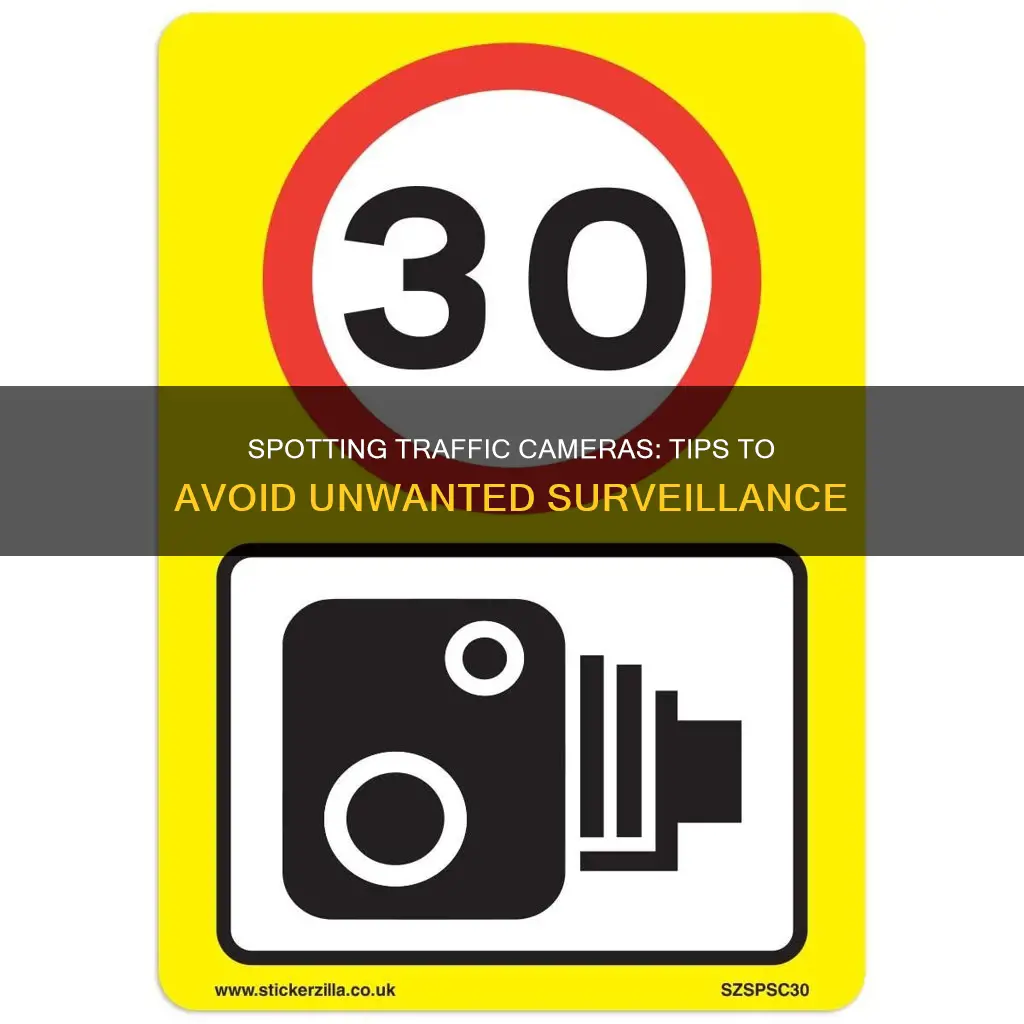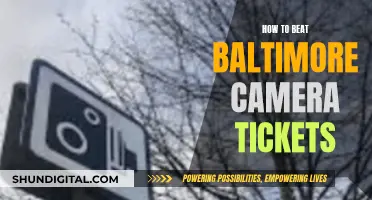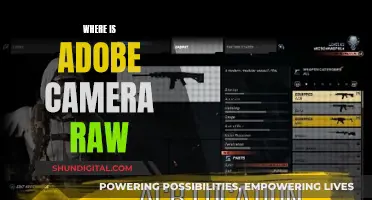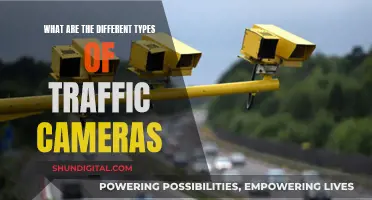
Traffic cameras are everywhere, and they serve a variety of purposes, including monitoring traffic congestion, law enforcement, and number plate recognition. They are usually placed along roadways to capture real-time footage of vehicular traffic and related activities. These cameras are equipped with advanced imaging technology, enabling them to monitor traffic conditions, detect violations, and facilitate incident management. There are several types of traffic cameras, including fixed cameras mounted on poles, mobile units deployed in vehicles or trailers, and specialized cameras for specific purposes such as red-light enforcement or speed monitoring. With the advancement of technology, it has become easier to access traffic cameras through online platforms, websites, and mobile applications.
| Characteristics | Values |
|---|---|
| Purpose | Monitoring and managing traffic flow, enhancing safety, and aiding law enforcement |
| Placement | Along roadways, at intersections, highway ramps, toll booths, urban areas, school zones, construction zones, public transport hubs |
| Types | Fixed cameras, mobile units, specialized cameras for red light enforcement or speed monitoring |
| Features | Advanced imaging technology, high-resolution lenses, radar or laser technology |
| Access | Online platforms, websites, traffic monitoring apps, navigation apps, dedicated traffic camera apps |
| Benefits | Real-time traffic updates, avoiding traffic jams and accidents, planning alternative routes |
What You'll Learn
- Traffic cameras are placed at traffic light junctions, expressways, under-developed areas, accident-prone areas, and speeding hotspots
- They are used for monitoring and managing traffic flow, enhancing safety, and aiding law enforcement
- They are accessible to the public through online platforms, websites, and traffic monitoring apps
- They are commonly fixed or mobile, with fixed cameras mounted on poles and mobile cameras deployed in vehicles or trailers
- To obtain traffic camera footage, contact relevant authorities or seek legal assistance

Traffic cameras are placed at traffic light junctions, expressways, under-developed areas, accident-prone areas, and speeding hotspots
Traffic cameras are placed strategically to monitor traffic flow, ensure road safety, and deter traffic violations. Here are the key locations where traffic cameras are typically placed:
Traffic Light Junctions
Red-light cameras are commonly placed at traffic light junctions or intersections to deter and detect vehicles from running red lights. These cameras are triggered by sensors installed in the road, capturing images or videos of vehicles that enter the intersection against a red light. This provides evidence for potential traffic violations and helps enforce traffic laws.
Expressways or Major Roads
Fixed speed cameras are typically located on expressways or big roads to detect speeding violations. These cameras are usually mounted on elevated poles on the side of the road and are enclosed in bulky weatherproof enclosures with external flashes. They are placed in areas with heavy vehicle traffic to monitor speeding and enforce speed limits.
Under-Developed Areas
Mobile speed cameras are often deployed in under-developed areas or locations with heavy vehicle presence. These cameras are not permanently mounted and can be placed on camera tripods or inside vans. They are moved around to different areas to monitor speeding in locations without fixed speed cameras.
Accident-Prone and High-Risk Areas
Police speed laser cameras are typically found in accident-prone and high-risk areas, such as overhead bridges, around corners, and bends. These cameras are manned and used to detect speeding violations in areas with a higher risk of accidents.
Speeding Hotspots
In addition to accident-prone areas, police speed laser cameras are also placed in speeding hotspots. These cameras are strategically positioned to target speeding violations in areas where speeding is prevalent.
The placement of traffic cameras in these locations helps enforce traffic laws, improve road safety, and manage traffic flow. They capture evidence of traffic violations, such as running red lights or speeding, which can be used for issuing tickets or fines to offending drivers.
Charging Your ADT Doorbell Camera: How Long Does It Take?
You may want to see also

They are used for monitoring and managing traffic flow, enhancing safety, and aiding law enforcement
Traffic cameras are an essential component of modern cities' transportation and logistics departments, playing a crucial role in monitoring and managing traffic flow, enhancing safety, and aiding law enforcement.
These cameras are strategically placed at various locations, including complex intersections, congested roads, and areas with frequent extreme weather conditions. Mounted on poles, bridges, or other structures, they provide a comprehensive view of traffic conditions. Once installed, they are connected to a control centre or network, allowing real-time monitoring of traffic flow by relevant authorities. This enables the detection of accidents or disruptions and facilitates prompt action, such as alerting news outlets to inform motorists and commuters, thereby helping them plan alternative routes.
Traffic cameras are also instrumental in enforcing traffic laws. Some cameras are equipped with sensors that detect vehicle speed, enabling authorities to issue tickets to speeding drivers. Red-light cameras, for instance, capture images of vehicles running red lights, aiding in the enforcement of traffic signals. Additionally, these cameras play a crucial role in reducing fatal car accidents. Studies have shown that intersections without red-light cameras have a 30% higher likelihood of fatal crashes than those with cameras.
Another type of traffic camera is the speed camera, which can be fixed or mobile. Fixed speed cameras are stationary, typically mounted on poles, and used to monitor speed at specific locations. On the other hand, mobile speed cameras are portable and can be moved to different areas. Both types of cameras use sensors to detect vehicle speed and capture images of speeding vehicles, aiding in the enforcement of speed limits.
Traffic cameras also encompass non-enforcement types, such as traffic sensor cameras, which are often small, cylindrical, or dome-shaped. These cameras are used to measure traffic patterns and flow and determine traffic light timing. They aid in monitoring traffic conditions and improving road efficiency without being tied to enforcement systems.
Lastly, Automated Number Plate Recognition (ANPR) cameras combine artificial intelligence with camera technology to read license plate numbers. These cameras can be mounted on police cruisers or poles and are used to track vehicle whereabouts. While this technology raises privacy concerns, it can also be beneficial for public safety, such as warning police officers of potential dangers.
Charging Camera Batteries: A Quick Guide to Powering Up
You may want to see also

They are accessible to the public through online platforms, websites, and traffic monitoring apps
Traffic cameras are essential tools for monitoring and managing traffic flow, enhancing safety, and aiding law enforcement. They are usually placed strategically along roadways to capture real-time footage of vehicular traffic and related activities. These cameras are easily accessible to the public through various online platforms, websites, and traffic monitoring apps.
Government agencies responsible for transportation management often maintain official websites where users can access live camera feeds, view traffic conditions, and receive updates on road closures, construction projects, and other pertinent information. These websites provide a valuable resource for commuters, enabling them to make informed decisions about their routes and travel timings.
In addition to websites, there are dedicated traffic monitoring apps that offer convenient access to traffic cameras on mobile devices. These apps, such as Google Maps, Waze, and Apple Maps, provide users with live camera feeds, traffic incident reports, and real-time updates on road conditions. The integration of traffic camera features into navigation apps empowers users to stay informed and make efficient travel choices.
Traffic camera networks operated by government agencies, transportation authorities, and private companies also provide centralized platforms for accessing multiple traffic camera feeds. These networks offer user-friendly interfaces, advanced search capabilities, and customizable viewing options, making it easier for users to find the information they need.
The accessibility of traffic cameras through online platforms, websites, and apps brings numerous benefits. It enables commuters to avoid traffic jams and accidents, plan alternative routes, and save time on their journeys. Additionally, it fosters a culture of shared responsibility for road safety and enhances collaboration between the public and stakeholders in transportation management.
By leveraging these easily accessible resources, individuals can stay informed about real-time traffic conditions, make better travel decisions, and contribute to more efficient and sustainable transportation systems.
Unlocking Square Mode Photography: A Guide to Creative Captures
You may want to see also

They are commonly fixed or mobile, with fixed cameras mounted on poles and mobile cameras deployed in vehicles or trailers
Traffic cameras are an essential tool for monitoring and managing traffic flow, enhancing road safety, and aiding law enforcement. They are commonly fixed or mobile, with fixed cameras mounted on poles and mobile cameras deployed in vehicles or trailers.
Fixed traffic cameras are permanently installed at strategic locations such as intersections, highway ramps, and toll booths. They are typically mounted on poles or structures and are equipped with advanced imaging technology, including high-resolution lenses, to capture detailed images and video footage of traffic activities. Fixed cameras provide a static and consistent viewpoint of the road and are particularly useful for monitoring traffic conditions, detecting violations, and facilitating incident management.
On the other hand, mobile traffic cameras offer flexibility and can be deployed in vehicles or trailers to address changing traffic conditions or specific enforcement needs. They can be easily relocated to monitor construction zones, special events, or areas prone to congestion or accidents. Mobile cameras provide a dynamic perspective and are valuable for managing fluid traffic situations or focusing on specific enforcement tasks.
Both fixed and mobile traffic cameras play a crucial role in road safety and traffic management. Fixed cameras provide a constant surveillance presence at critical locations, while mobile cameras offer adaptability and responsiveness to evolving traffic conditions. The strategic placement of these cameras helps in enforcing traffic laws, reducing the risk of collisions, and improving overall road safety for commuters.
By understanding the types and purposes of fixed and mobile traffic cameras, individuals can better navigate the roads, make informed decisions about route planning, and contribute to a safer and more efficient transportation system.
Cameras on Cars: London's Surveillance Network
You may want to see also

To obtain traffic camera footage, contact relevant authorities or seek legal assistance
Traffic camera footage can be crucial in determining the cause of a car accident and holding responsible parties accountable. However, obtaining this footage can be complex and frustrating. Here is a step-by-step guide to help you obtain traffic camera footage by contacting relevant authorities or seeking legal assistance:
Step 1: Identify Camera Location and Jurisdiction
First, identify the location of the traffic camera that may have captured the incident. You can do this by reviewing a police report or contacting the local police department or department of transportation. Once you know the camera's location, you can determine its jurisdiction. The jurisdiction will help you identify which agency to contact for the footage.
Step 2: Contact the Appropriate Agency
After identifying the jurisdiction, contact the relevant agency to request the video footage. This may be the local police department, department of transportation, or a private company, depending on who operates the camera.
Step 3: Request the Video Footage
When contacting the agency, be prepared to provide details about the incident, including the date, time, and location. Follow up on your request to ensure it is being processed. The agency may require a release form and may charge a fee for providing the footage.
Step 4: Review the Footage
Once you receive the footage, review it carefully. Take note of any details that may help determine the cause of the incident, such as vehicle positions and speeds. Remember that the footage may contain sensitive information, so use it responsibly.
Step 5: Seek Legal Advice
If you are unsure about how to proceed after obtaining the footage, consider seeking legal advice from an experienced attorney. They can help you understand your rights and obligations and advise you on using the footage effectively to support your case.
Important Considerations:
- Act quickly: Traffic camera footage is typically stored for a limited time, ranging from a few days to several weeks or months. Once the footage is recorded over or deleted, it is usually unrecoverable.
- Privacy and permissions: Some agencies may require a release form to ensure the footage is used only for personal or permitted purposes.
- Fees: Inquire about any fees associated with obtaining the footage to avoid unexpected charges.
- Persistence and follow-up: The process of obtaining footage can be time-consuming and complex. Be persistent in your requests and follow up regularly to ensure your request is being addressed.
Editing in Camera Raw: A Pre-Lightroom Must-Do?
You may want to see also
Frequently asked questions
Traffic cameras are usually placed along roadways, at intersections, highway ramps, toll booths, and urban areas. You can check online platforms, websites, and traffic monitoring apps such as Google Maps, Waze, and Apple Maps to access live camera feeds and view traffic conditions in your area.
There are fixed traffic cameras that are permanently installed at specific locations such as intersections and highway ramps. Mobile traffic cameras are deployed in vehicles or trailers and can be moved to different locations as needed. Specialized traffic cameras are used for specific tasks like red-light enforcement or speed monitoring.
Traffic cameras serve as tools for monitoring and managing traffic flow, enhancing road safety, aiding law enforcement, and reducing the risk of collisions at high-risk locations. They help in enforcing traffic laws, such as deterring and detecting vehicles running red lights or speeding.







